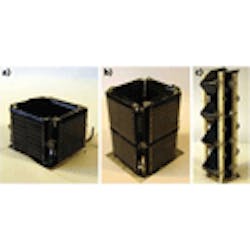3D solar cells generate up to 20 times more energy
Flat-panel solar photovoltaic (PV) designs benefit tremendously from tracking hardware; however, such hardware increases installation costs and cost per watt—especially for residential installations. An alternative to tracking is a newly designed 3D solar configuration from the Massachusetts Institute of Technology (MIT; Cambridge, MA). While the 3D PV design increases the required flat-panel area, the PV panels themselves are often the lowest-cost component in a solar installation.
Using standard Monte Carlo simulations and genetic algorithms, a series of triangular structures was arranged to optimize energy density by minimizing cell shading and maximizing the re-absorption of light reflected by surrounding cells. The result was a series of structures—an open cube (one- and two-level) with panels both inside and outside as well as a ridged tower structure—that increased energy generation by 2 to more than 20 times that of a flat, untracked panel of the same base area, respectively. The increase is primarily due to the ability to harvest energy over a longer time period during the day, especially when the sun is at lower elevation angles. Due to the enhanced ability to collect diffuse and scattered light, 3D PV structures can also generate more power during cloudy weather compared to flat panels. Other 3D designs such as an open-flower structure are being developed using biomimetic principles to further increase energy generation. Contact Jeffrey C. Grossman at [email protected].
About the Author

Gail Overton
Senior Editor (2004-2020)
Gail has more than 30 years of engineering, marketing, product management, and editorial experience in the photonics and optical communications industry. Before joining the staff at Laser Focus World in 2004, she held many product management and product marketing roles in the fiber-optics industry, most notably at Hughes (El Segundo, CA), GTE Labs (Waltham, MA), Corning (Corning, NY), Photon Kinetics (Beaverton, OR), and Newport Corporation (Irvine, CA). During her marketing career, Gail published articles in WDM Solutions and Sensors magazine and traveled internationally to conduct product and sales training. Gail received her BS degree in physics, with an emphasis in optics, from San Diego State University in San Diego, CA in May 1986.
